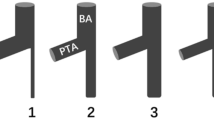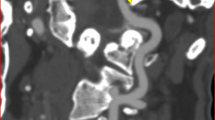Abstract
Objective
To evaluate vertebral artery anomaly at the craniovertebral junction (CVJ) in patients with basilar invagination (BI) by computed tomographic angiography (CTA), and to discuss the prevention strategy of vascular injury.
Methods
The primary axial, multiple planar reconstruction and volume-rendering cervicocranial CTA images of 39 BI patients were analysed to evaluate vertebral artery anomaly at the CVJ: persistent first intersegmental artery (PFIA), fenestrated vertebral artery (FEN), and extracranial C1/2 origin of posterior inferior cerebellar artery (PICA), high-riding vertebral artery, side-to-side asymmetry and irregular midline carotid artery loop was determined by subjective vision. 100 patients who underwent CTA for reasons other than CVJ deformity were enrolled as normal controls to evaluate the prevalence of vertebral artery anomaly in a normal population. Chi-square test was utilized for comparing the prevalence of vertebral artery anomaly between these two groups.
Results
The incidence of PFIA was 25.6% (10/39), FEN was 7.7% (3/39), PICA was 5.1% (2/39), and the total incidence of extraosseous anomalous course of vertebral artery was 38.5% (15/39), significantly higher than that of control group, 7.0% (7/100) (P < 0.01). The incidence of high-riding vertebral artery and side-to-side asymmetry were 61.5% (24/39) and 30.8% (12/39), respectively. An irregular midline carotid artery loop was observed in five patients (12.8%).
Conclusion
Vertebral artery anomaly, which can be clearly depicted by CTA, is more frequent in BI patients. Preoperative CTA should be performed for this patient population to prevent vascular injury.
Graphical abstract
These slides can be retrieved under Electronic Supplementary Material.







Similar content being viewed by others
References
Chamberlain’s WE (1939) Basilar impression (platybasia): a bizarre developmental anomaly of the occipital bone and upper cervical spine with striking and misleading neurologic manifestations. Yale J Biol Med 11:487–496
Pang D, Thompson DN (2011) Embryology and bony malformations of the craniovertebral junction. Childs Nerv Syst 27(4):523–564
Riew KD, Hilibrand AS, Palumbo MA, Sethi N, Bohlman HH (2001) Diagnosing basilar invagination in the rheumatoid patient. J Bone Jt Surg 83:194–200
Chaudhry NS, Ozpinar A, Bi WL (2015) Basilar invagination: case report and literature review. World Neurosurg 83:1187-11
Klekamp J (2014) Treatment of basilar invagination. Eur Spine J 23(8):1656–1665
Magerl F, Seemann PS (1987) Stable posterior fusion of the atlas and axis by transarticular screw fixation. In: Kehr P, Weidner A (eds) Cervical spine, vol 1. Springer, New York, pp 322–327
Leconte P (1964) Fracture et luxation des deux premieres vertebres cervicales. In: Judet R (ed) Luxation Congenenitale de la Hanche. Fractures du Cou-de-pied Rachis Cervical. Actualites de Chirugie Orthopedique de Hopital Raymond-Poincare 3:147–166
Goel A, Laheri V (1994) Plate and screw fixation for atlanto-axial subluxation. Acta Neurochir 129:47–53
Goel A, Kulkarni AG (2004) Mobile and reducible atlantoaxial dislocation in presence of occipitalized atlas: report on treatment of eight cases by direct lateral mass plate and screw fixation. Spine 29:520–523
Puttlitz CM, Melcher RP, Kleinstueck FS (2004) Stability analysis of craniovertebral junction fixation techniques. J Bone Jt Surg Am 86:561–568
Abumi K, Takada R, Shono Y (1999) Posterior occipitocervical reconstruction using cervical pedicle screws and plate-rod systems. Spine 24:1425–1434
Ondra SL, Marzouk S, Ganju A (2006) Safety and efficacy of C2 pedicle screws placed with anatomic and lateral C-arm guidance. Spine 31:263–267
Ebraheim N, Rollins JR Jr, Xu R (1996) Anatomical consideration of the C2 pedicle screw placement. Spine 21:691–695
Grob D, Jeanneret B, Aebi M (1991) Atlanto-axial fusion with transarticular screw fixation. J Bone Jt Surg Br 73:972–976
Harms J, Melcher RP (2001) Posterior C1–C2 fusion with polyaxial screw and rod fixation. Spine 26:2467–2471
Jeanneret B, Magerl F (1992) Primary posterior fusion C1/2 in odontoid fractures: indications, technique, and results of transarticular screw fixation. J Spinal Disord 5:464–475
Stillerman CB, Wilson JA (1993) Atlanto-axial stabilization with posterior transarticular screw fixation: technical description and report of 22 cases. Neurosurgery 32:948–955
Aota Y, Honda A, Uesugi M, Yamashita T, Baba N, Niwa T (2006) Vertebral artery injury in C-1 lateral mass screw fixation. Case illustration. J Neurosurg Spine 5:554
Rocha R, Safavi-Abbasi S, Reis C, Theodore N, Bambakidis N, de Oliveira E (2007) Working area, safety zones, and angles of approach for posterior C-1 lateral mass screw placement: a quantitative anatomical and morphometric evaluation. J Neurosurg Spine 6:247–254
Wright NM, Lauryssen C (2008) Vertebral artery injury in C1–2 transarticular screw fixation: results of a survey of the AANS/CNS section on disorders of the spine and peripheral nerves. J Neurosurg 1998 88:634–640
Neo M, Fujibayashi S, Miyata M, Takemoto M, Nakamura T (2008) Vertebral artery injury during cervical spine surgery: a survey of more than 5600 operations. Spine (Phila Pa 1976) 33(7):779–785
Yoshida M, Neo M, Fujibayashi S (2006) Comparison of the anatomical risk for vertebral artery injury associated with the C2-pedicle screw and atlantoaxial transarticular screw. Spine 31:513–517
Jian FZ, Chen Z, Wrede KH (2010) Direct posterior reduction and fixation for the treatment of basilar invagination with atlantoaxial dislocation. Neurosurgery 66:678–687
Yeom JS, Buchowski JM, Park KW, Chang BS, Lee CK, Riew KD (2008) Undetected vertebral artery groove and foramen violations during C1 lateral mass and C2 pedicle screw placement. Spine (Phila Pa 1976) 33(25):942–949
Wakao N, Takeuchi M (2014) Vertebral artery variations and osseous anomaly at the C1–2 level diagnosed by 3D CT angiography in normal subjects. Neuroradiology 56:843–849
O’Donnell CM, Child ZA (2014) Vertebral artery anomalies at the craniovertebral junction in the US population. Spine 39:1053–1057
Yamazaki M, Okawa A, Furuya T, Sakuma T, Takahashi H, Kato K, Fujiyoshi T, Mannoji C, Takahashi K, Koda M (2012) Anomalous vertebral arteries in the extra- and intraosseous regions of the craniovertebral junction visualized by 3-dimensional computed tomographic angiography: analysis of 100 consecutive surgical cases and review of the literature. Spine 37:1389–1397
Wang S, Wang C, Liu Y, Yan M, Zhou H (2009) Anomalous vertebral artery in craniovertebral junction with occipitalization of the atlas. Spine 34:2838–2842
Abtahil AM, Brodke DS (2014) Vertebral artery anomalies at the craniovertebral junction: a case report and review of the literature. Evid Based Spine Care J 5:121–125
Hong JT, Lee SW, Son BC, Sung JH, Yang SH, Kim IS, Park CK (2008) Analysis of anatomical variations of bone and vascular structures around the posterior atlantal arch using three-dimensional computed tomography angiography. J Neurosurg Spine 8:230–236
Mazzatenta D, Zoli M, Mascari C, Pasquini E, Frank G (2014) Endoscopic endonasal odontoidectomy: clinical series. Spine 39:846–853
Tokuda K, Miyasaka K, Abe H (1985) Anomalous atlantoaxial portions of vertebral and posterior inferior cerebellar arteries. Neuroradiology 27:410–413
Kim JT, Lee HJ, Kim JH (2016) Quantitative analysis of unusual entrance of the vertebral artery into the cervical foramen (V2 segment) and its clinical implications. Eur Spine J 25:4188–4194
Eksi MS, Toktas ZO, Yilmaz B (2016) Vertebral artery loops in surgical perspective. Eur Spine J 25:4171–4180
Sivaraju L, Mani S, Prabhu K (2017) Three-dimensional computed tomography angiographic study of the vertebral artery in patients with congenital craniovertebral junction anomalies. Eur Spine J 26:1028–1038
Madawi AA, Casey ATH, Solanki GA (1997) Radiological and anatomical evaluation of the atlantoaxial transarticular screw fixation technique. J Neurosurg 86:961–968
Mandel IM, Kambach BJ, Petersilge CA (1998) Morphologic considerations of C2 isthmus dimensions for the placement of transarticular screws. Spine 2000 25:1542–1547
Jun BY (1998) Anatomic study for ideal and safe posterior C1–C2 transarticular screw fixation. Spine (Phila Pa 1976) 23(15):1703–1707
Paramore CG, Dickman CA, Sonntag VK (1996) The anatomical suitability of the C1–2 complex for transarticular screw fixation. J Neurosurg 85:221–224
Igarashi T, Kikuchi S, Sato K (2003) Anatomic study of the axis for surgical planning of transarticular screw fixation. Clin Orthop Relat Res 408:162–166
Neo M (2008) An essential principle for safe C1–C2 transarticular screw insertion. J Spine Disord Tech 21(1):76–77
Lapsiwala SB, Anderson PA, Oza A, Resnick DK (2006) Biomechanical comparison of four C1 to C2 rigid fixative techniques: anterior transarticular, posterior transarticular, C1 to C2 pedicle, and C1 to C2 intralaminar screws. Neurosurgery 58(3):516–521
Resnick DK, Lapsiwala S, Trost GR (2002) Anatomic suitability of the C1–C2 complex for pedicle screw fixation. Spine 27:1494–1498
Acknowledgements
The authors would like to thank the staff members of the institutes.
Author information
Authors and Affiliations
Corresponding author
Ethics declarations
Conflict of interest
On behalf of all authors, the corresponding author states that there is no conflict of interest.
Electronic supplementary material
Below is the link to the electronic supplementary material.
Rights and permissions
About this article
Cite this article
Xu, S., Ruan, S., Song, X. et al. Evaluation of vertebral artery anomaly in basilar invagination and prevention of vascular injury during surgical intervention: CTA features and analysis. Eur Spine J 27, 1286–1294 (2018). https://doi.org/10.1007/s00586-017-5445-4
Received:
Revised:
Accepted:
Published:
Issue Date:
DOI: https://doi.org/10.1007/s00586-017-5445-4




